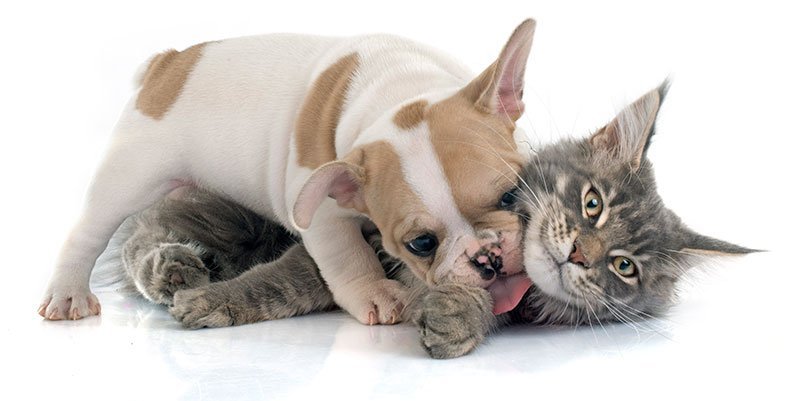Feline Meets Canine: A Guide on How to Introduce Cats to Dogs
As pet lovers, we know how difficult it can be to introduce two animals from different species. Cats and dogs are known to be archrivals, but with the right approach, they can learn to coexist peacefully. In this article, we’ll provide you with a comprehensive guide on how to introduce cats to dogs and dogs to cats. We’ll explain the dos and don’ts of the introduction process, as well as warning signs when introducing cats and dogs.
Do dogs and cats get along?
The relationship between cats and dogs is often portrayed as being full of conflict. However, that is not always the case. Do dogs and cats get along? Yes, absolutely if introduced properly. The key to success is to ensure that both animals feel safe and secure in each other’s presence.
It’s important to remember that cats and dogs have different personalities and needs. Cats are independent and prefer to have their own space, while dogs are social and enjoy being around people and other animals. Therefore, it’s important to take their individual needs into consideration when introducing them.
Understanding your cat’s behaviour
Before introducing your cat to a dog, it’s important to understand their behaviour. Cats are territorial animals, and they need a safe space to call their own. They are also creatures of habit, and they prefer a routine.
When introducing a cat to a dog, it’s important to ensure that the cat has their own space where they can retreat to if they feel threatened or uncomfortable. It’s also important to avoid disrupting the cat’s routine as much as possible.
Cats communicate through body language, and it’s important to pay attention to their behaviour when introducing them to a dog. If your cat is hissing, growling, or has their ears pinned back, they are likely feeling threatened or uncomfortable.
Understanding your dog’s behaviour
Dogs are social animals, and they thrive on human companionship. However, not all dogs are the same, and it’s important to understand their behaviour before introducing them to a cat.
Some dogs have a high prey drive, which means that they are more likely to chase and attack small animals, such as cats. It’s important to be aware of your dog’s prey drive and take it into consideration when introducing them to a cat.
It’s also important to ensure that your dog is well-trained and obedient. A well-trained dog is less likely to chase or attack a cat. Have plenty of dog food treats on hand to use as rewards.
Preparing your home for introducing cats and dogs
Before introducing your cat and dog, it’s important to prepare your home. You’ll want to create a safe space for your cat where they can retreat to if they feel threatened or uncomfortable.
You’ll also want to ensure that your home is free of any hazards that could harm your cat or dog. This includes ensuring that your home is free of toxic plants and chemicals, and that there are no open windows or doors that could allow your pets to escape.
It’s also a good idea to provide your cat with their own cat food, water, and litter box. Cats prefer to have their own space, and having their own food and litter box can help them feel more secure.

Introducing cats and dogs – the dos and don’ts
When introducing cats and dogs, it’s important to follow some basic dos and don’ts.
The Dos
- Introduce your pets gradually, starting with short periods of time together.
- Use positive reinforcement to reward good behaviour, such as with treats.
- Provide your cat with a safe space where they can retreat if they feel threatened or uncomfortable.
- Supervise all interactions between your pets.
- Keep your dog food and your cat food separate, ideally with the cat’s food up high in a place that’s harder for the dog to reach.
The Don’ts
- Never force your pets to interact with each other.
- Never leave your pets unsupervised together.
- Never punish your pets for bad behaviou
Warning signs when introducing cats and dogs
When introducing cats and dogs, it’s important to be aware of warning signs that could indicate that the introduction is not going well.
- Hissing, growling, or ears pinned back on the cat.
- Stalking or aggressive behaviour from the dog.
- Frequent fights or altercations.
If you notice any of these warning signs, it’s important to separate your pets and seek professional help.
Additional tips for introducing cats and dogs
Here are some additional tips that can help make the introduction process go smoothly.
- Provide your pets with plenty of exercise and playtime to help them burn off energy.
- Use food treats and toys to divert your pets from each other. A dog bone is an ideal distraction for your pooch and will keep them busy for quite a while.
- Consider using pheromone sprays or diffusers to help calm your pets.
- Separate your pets if they are having frequent altercations.
- Start the introduction process when your pets are young if possible.
- Use a baby gate or screen door to separate your pets, allowing them to see and smell each other without being able to physically interact.
- Consider using a playpen to introduce your pets.
Introducing cats to dogs can be a challenging process, but with the right approach, it can be done successfully. Remember to take your pets’ individual needs into consideration, and to provide them with a safe space where they can retreat if they feel threatened or uncomfortable. If you notice any warning signs, don’t hesitate to seek professional help. By following these tips, your cat and dog can learn to coexist peacefully and even become the best of friends.

